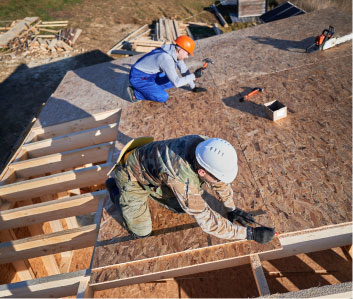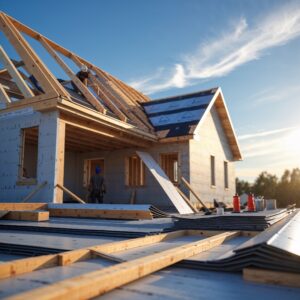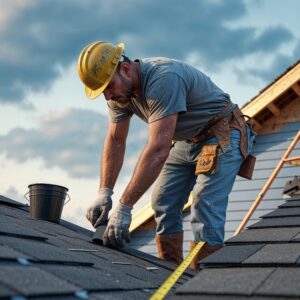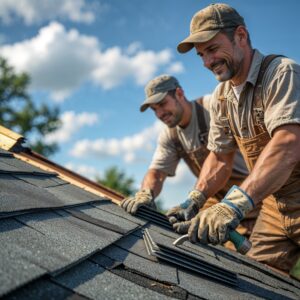Roof coating extends your roof’s average lifespan by enhancing its durability and minimising the effect of harsh environmental elements. These protective barriers shield against UV rays, prevent moisture from seeping inside and withstand temperature fluctuations that could lead to early roof replacement.
Roofing is an essential component of your home to protect the residents from outside harsh conditions. But even the sturdiest materials used in manufacturing roofs should experience wear and tear over time. Layering protective sealants can minimise the common damaging factors and sustain your roof’s effectiveness for years to come.
How Roof Coating Works?
Roof coatings are specialised materials applied to the surface of an existing roof. They create a seamless, watertight layer on top to enhance the durability and performance of your attic. These coverings stretch and contract with temperature changes, making them ideal for warm climates and preventing leaking spots. Reflective roof sealants effectively decrease the damage and maintain the indoor atmosphere due to their ability to reduce heat absorption from the sun.
In simple words, roof coatings work as a buffer that absorbs the brunt of weather impacts, UV rays and moisture while preserving the roof’s structural integrity and exceeding its average lifespan.
How Roof Coating Extend the Lifespan? | Key Benefits Explained
Roof paints provide adequate protection against surrounding factors and benefit your roofing material’s longevity. These treatments shield your attic from daily wear and tear and can add up to 10-15 years to the life of your roof. Homeowners could use these coatings to delay the need for costly roof replacements.
Prevent Weather Damage Due to Flexibility
Spraying your roof with protective liquid creates a barrier against weather elements. It reinforces the roof surface’s ability to withstand heavy winds, hail, and debris buildup that can cause material deterioration. High-quality elastomeric coatings can stretch and accommodate roof movement due to temperature changes without cracking. This flexibility provided by roof treatments plays a crucial role in extending shingle life, especially in regions of heavy winds, like Norwich and freezing temperatures.
Enhanced Durability Against Environmental Elements
Many coatings contain 80-95% solids that form a thick, durable layer on your roof structure. They enhance the adhesion and resistance to abrasions, ensuring long-lasting material performance even under stress. Timely roofing treatments protect the underlying materials from physical damage and cracking, which effectively prolongs the roof’s longevity by 10 to 20 years based on the coating type and roof condition.
UV Protection to Avoid Roof Cracking and Discolouration
Your roof is directly exposed to UV rays, which can lead to material degradation over time and cause it to become brittle, crack, or fade in colour. Homeowners can prevent these adverse effects by forming a protective layer on the existing roof. This will maintain the roof’s structural integrity and appearance for an extended period.
Most roof coatings have deflective abilities to move solar radiation away from the roof surface. They also contain UV inhibitors that block the rays and protect roofing materials from the damaging effects of the sun, ultimately increasing their replacing age.
Reduce Thermal Stress on Roofing Materials
Cool roof coatings are made to reflect a substantial amount of sunlight, up to 90% in some cases. This high solar reflectivity reduces heat absorption and keeps roof surfaces cooler. When less heat enters the building, it lowers the demand for air conditioning during hot months and leads to significant energy savings.
Some shingle coatings also provide insulative properties and thermal emittance that stabilise indoor temperatures. By reducing the thermal stress on the material, coats prolong the roof life and reduce the frequency of repairs and replacements.
Cost-Effective Solution to Extend Your Roof Life
Investing in protective coatings is a cost-effective solution to extending roof life. They reduce maintenance needs and lengthen the time between repairs or replacements. Applying a coating can cost between $0.50 and $9 per square foot, which is far from thousands to spend on replacements. This proactive measure can prevent the larger investment for 10 to 20 years if properly maintained.
Waterproofing Capabilities to Prevent Roof Leaking
Layering your roof with waterproof materials creates a membrane to cover the seams and joints where water can penetrate. This will helo homeowners to avoid leaks and water damage to your roof surface. The lack of seams is typically beneficial for flat roofs in Norwich, which are more prone to water accumulation. Consider silicon-based ones because they are specifically created to withstand ponding water without degrading and prevent structural degradation due to moisture infiltration over time. These coatings maintain roof integrity even in wet conditions and enhance the roof’s overall durability.
Which Roof Coating Materials Can Make Them Last Long?
To maintain your roof structure and ensure longevity, choose the roof coating that addresses specific needs and offers all the essential features to extend the roof life. There are various types, each providing unique advantages and contributing to long-term cost savings. But before selecting the types, consider factors such as existing roof material, climate conditions, and specific building requirements.
Acrylic | Effective UV Inhibitor
Ideal for— Metal, modified bitumen and single-ply membranes
- These are water-based solutions formulated primarily from 100% acrylic resins. Acrylic coatings are known for their excellent UV resistance and reflectivity. Studies indicate that they can decrease surface temperatures by as much as 20°F when exposed to direct sunlight.
- Acrylic coats are cost-effective, eco-friendly, and available in various colours. They last between 10 to 20 years or even longer with timely reapplication to protect your roof from damage and prolong its age up to this respective time.
| How often should roof coating be reapplied?Most roof coatings last 5 to 15 years or sometimes more, depending on the material, layer thickness, and environmental exposure. Experts recommend inspecting your roof coat every 3 to 5 years for wear-downs. If you see cracking and thinning in any part, consider reapplication promptly. Generally, Acrylic coatings might need reapplication every 5 to 10 years, while silicone coatings can last longer, potentially up to 15 years. |
Silicone | Excellent Weather Resistant
Ideal for— Metal, EPDM and built-up roofs.
- Offers superior waterproofing capabilities and is highly resistant to ponding water after heavy rain.
- Accommodates temperature fluctuations without cracking and prolongs the roofing life expectancy.
- A properly applied silicone over the roof surface safeguards your roofing material for up to 15 to 20 years.
Polyurethane | Works Well Against Physical Damage
Ideal for— commercial roofs exposed to heavy equipment or foot traffic.
- Known for toughness and elasticity.
- Provide excellent resistance to foot traffic and mechanical damage to roofs.
- Form a seamless waterproof membrane that protects your roof against leakage and physical damage, prolonging its longevity without significant repairs.
- Waterproofing application of polyurethane can exceed the age of your roof by up to 25 years.
Elastomeric | Normalize Temperature Fluctuations
Ideal for— metal, concrete and modified bitumen roofing systems.
- Expand and contract with temperature changes.
- Highly flexible and elastic, reducing the risk of cracks and leaks.
- Exceptionally durable, with a lifespan of 10 to 20 years based on the thickness applied to protect the roof surface.
How Should You Apply a Roof Coat?
Proper application is crucial for maximising the benefits of roof coatings. It is not as simple as painting layers over your existing roof. Before applying, ensure your roof is in good enough shape to benefit from coverings. If there is any issue, it is better to fix it and then apply the coat for long-term effects.
Select appropriate layering material that matches your climatic condition and roof material. For instance, Acrylic works well in dry, sunny environments due to its UV stability.
- First, clean your roof from any debris, as it can affect adhesion.
- Prime the surface for elastomeric coating.
- Apply coating evenly across the roof surface by using a roller or brush.
- Allow the first coat to dry completely for 24 to 48 hours, then apply the second layer in the opposite direction.
- Consider hiring a professional roofer for the best results.
Conclusion
Roof coatings extend your roof life by providing adequate protection and preserving its structural integrity. They make a shield between various harsh components like UV rays and stormy conditions to prevent common repairing issues. By choosing the appropriate type of coating, with the proper application and maintenance, homeowners can avoid early roof replacements. They are the cost-effective, sustainable way to prolong your roof life.




